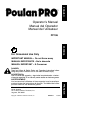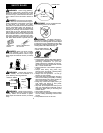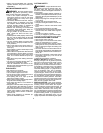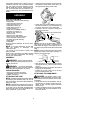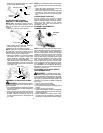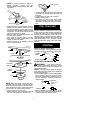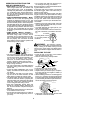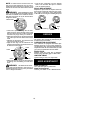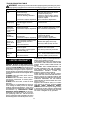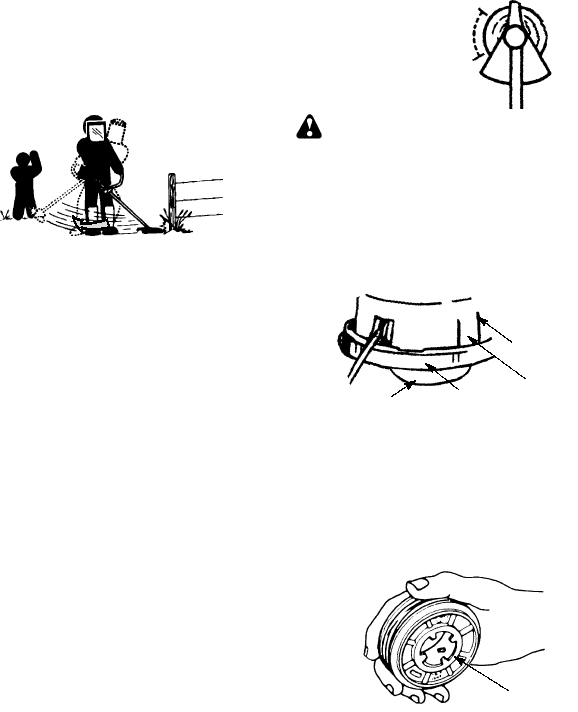
9
OPERATING INSTRUCTIONS FOR
USE WITH BRUSH BLADE
S
Blade Thrust i s a r eaction that only occurs
when using a bladed uni t. This r eaction can
cause serious injury such as amputation.
Carefully study this section. It is impor tant that
you understand w hat causes bl ade thrust,
how you can reduce the chance of its occur-
ring, and howyou can remain in control of unit
if blade thrust occurs .
S
WHA T CAUSES BLADE THRUST -- Blade
Thrust can occur when the s pinning blade
contacts an object that it does not cut. This
contact causes the bladeto stop for aninstant
and then suddenly move or “thrust” awayfrom
the object that washit. The “thrusting” reaction
can be violent enoughtocause the operatorto
be propelled in any direction and lose control
of the unit. The uncontrolled uni t can cause
seriousinjuryiftheblade contacts theoperator
or others.
S
WHEN BLADE THRUST OCCURS --
Blade Thrust can occur without warning if
the blade s nags, stalls, or binds. This is
more likely to occur in a reas where it is d iffi-
cult to see the material being cut. By using
the unit properly, the occurrence of blade
thrust wi ll be reduced and the operator will
be less likely to lose control.
S
Cut only grass, weeds, and woody brush up
to 2 inches i ndiameter with the brush blade.
Do not let the blade contact material it can-
not cut such as stumps, rocks, fences,
metal, etc., orclusters of hard, woody brush
having a diameter greater than 2 inches.
S
Keep the blade sharp. A dull blade is more
likely to snag and thrust.
S
Cut only at full throttle. The blade will have
maximum cutting power and is less likely to
bind or stall.
S
“Feed” the blade deliberately and not t oo
rapidly. The blade can thrust away if it is fed
too rapidly.
S
Cut only from your right to your left. Swing-
ing the unit in the same direction as the
blade spins increases the cutting action.
S
Use the shoulder strap and keep a firm grip
on the unit with both hands. A properly ad-
justed shoulder strap w ill support the weight
of the unit, freeing your arms and hands to
control and guide the cutting motion.
S
Keep feet comfortably spread apart and
braced for a possible sudden, rapid thrust of
unit. Do not over r each. Keep firm footing and
balance.
S
Keep blade below waist level; it will be eas-
ier to maintain control of unit.
S
Do not raise the engine above your waist as
the blade can come dangerously close to
your body.
S
Do not swing unit with such force that you
are in danger of losing your balance.
Bring the engine to cutting speed before enter-
ing the material to be cut.
If the blade does not turn when you squeeze
the throttle trigger, make sure tube is fully in-
serted into the engine.
Always release the throttle trigger and allow
engine toreturn toidle speedwhen notcutting.
The blade should not turn while the engine is
running at idle. If the blade turns at idle, do not
use your unit. Refer to the Carburetor adjust-
ment section or contact your Authorized Ser-
vice Dealer.
S
Maintain good firm footing while using the
unit. Dothis by planting feet firmly in a com-
fortable apart position.
S
Cut while swinging the upper part of your
body from ri ght to left.
S
As you move forward to the next area to cut,
be sure to maintain your balance and foot-
ing.
Cut using the 8 o’clock
to 10 o’clock position of
the blade
10 o’clock
8 o’clock
WARNING:
The operator or others
must not try to clear away cut material with the
engine running or the blade turning to avoid
serious injury. Stop engine and blade before
removing materials wrapped around blade or
tube.
REPLACING THE LINE
S
Press the tab on the side of the trimmer
head and twist the lock ring.
S
Remove the lock r ing and tap button.
Tab
Lock Rin
g
Tap Button
Trimmer
Head
S
Pull spool out of the trimmer head.
S
Clean dirt and debri s from all parts.
S
Replace with apre-wound spool ,or replace
line using two 20 foot lengths of 0.080” (2
mm) diameter line.
S
When installing new line on a n existing spool,
insert 1/16
I
of the line into the anchoring hole
in the bed of the spool, and wrapthe line even-
ly and and firmly ar oundthe spool in thedirec-
tion of the ar row found on the spool.
Anchoring
Hole
S
Insert ends of the lines through the exit holes
in the sides of the tr immer head.



